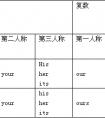用所给动词的适当形式填空。1. Sally _____ (like) to look at the pictures of Beijing Opera. 2. ---How much _____ (be) your new pants? ---They're $20. 3. On -七年级英语
当主语为第三人称单数时,谓语动词用单数第三人称形式。
| 规则 | 动词原形 | 第三人称 单数形式 | |
| s | 一般在词尾加s(读音规则: 清清浊浊元浊, 在清辅音后读清辅音/s/, 在浊辅音和元音后读/z/) |
stop take clean play grow |
stops/s/ takes/s/ cleans/z/ plays/z/ grows/z/ |
| es | 以,x,ch,sh,或o结尾的动词 加-es(读/iz/) |
pass fix wash watch do |
passes fixes washes watches does |
| ies | 以辅音字母 加y结尾的动词,变y为ies(读/iz/) |
fly carry hurry |
flies carries hurries |
注意:不规则变化的有have—has, be—is, go—goes, do—does
一般现在时,当主语是第三人称单数时,谓语动词要用第三人称单数形式
主语是第三人称单数有以下几种情况:
(1) 不可数名词做主语:
Some water is in the glass
(2) 单个的可数名词做主语:
The girl is Chinese. My watch is on the dresser.
(3) He ,she , it 等代词单个做主语:
He is in the tree. She likes her family very much.
(4) 单个的人名,地名或称呼作主语:
Mary is a doctor. Uncle Li speaks a little English.
Changchun is a beautiful city.
(5) 指示代词this, that 等作主语:
This is a pear. That is an apple .
(6) Everyone, everything ,something, nobody, nothing.等不定代词作主语时
Is everyone here today? Everything is ok .
(7)单个数字作主语时:
”8” is a good number in China.
动词单数第三人称形式的一般现在时的句子的否定句、疑问句及特殊疑问句。 <?xml:namespace prefix = "o" ns = "urn:schemas-microsoft-com:office:office" />
否定句:
在主语的后面实义动词前加doesn’t(注意实义动词应恢复原形。)
主语(单三)+doesn’ + 动词原形+其他
Jim likes football变否定: Jim doesn’t like football
He has lunch at school. 变否定:He doesn’t have lunch at school.
一般疑问句及答语,在句子前面加助动词does. 实义动词恢复原形
Does +主语(单三)+ 动词原形+其他
Does your father work ? Yes, he does. /No, he doesn’t
特殊疑问句:特殊疑问词+一般疑问句
特殊疑问词+ does +主语(单三)+ 动词原形+其他
Where does a bird live ?
How does she go to school?
考点名称:助动词的单数第三人称形式
- 助动词的单三形式:
助动词
be
do
have
shall
will
单三形式
is
does
has
shall
will
考点名称:助动词
- 助动词:
协助主要动词构成谓语动词词组的词叫助动词。
助动词是语法功能词,自身没有词义,不可单独使用,只能和别的动词一起构成谓语,表示时态、语态、语气等,或表示疑问或否定。
常用的助动词有:
be,do,does,did,have,has,shall,will,would等。 常见助动词用法:
have的用法:
have作助动词
形式:
主要变化形式:have,has,had
动名词/现在分词:having
1)have +过去分词,构成完成时态,例:
He has left for London. 他已去了伦敦。
By the end of last month, they had finished half of their work.
上月末为止,他们已经完成工作的一半。
2)have + been +现在分词,构成完成进行时(现在完成时),例:
I have been studying English for ten years.我一直在学英语,已达十年之久。
3)have+been +过去分词,构成完成时态的被动语态,例:
English has been taught in China for many years.中国教英语已经多年。
do的用法:
形式
主要变化形式:do,did,done
动名词/现在分词:doing
1) 构成一般疑问句,例如:
Do you want to pass the CET?你想通过大学英语测试吗?
Did you study German? 你们学过德语吗?
2)do + not 构成否定句,例如:
I do not want to be criticized.我不想挨批评。
He doesn't like to study.他不想学习。
In the past, many students did not know the importance of English.过去,好多学生不知道英语的重要性。
3) 构成否定祈使句,例如:
Don't go there. 不要去那里。
- 最新内容
- 相关内容
- 网友推荐
- 图文推荐
| [家长教育] 孩子为什么会和父母感情疏离? (2019-07-14) |
| [教师分享] 给远方姐姐的一封信 (2018-11-07) |
| [教师分享] 伸缩门 (2018-11-07) |
| [教师分享] 回家乡 (2018-11-07) |
| [教师分享] 是风味也是人间 (2018-11-07) |
| [教师分享] 一句格言的启示 (2018-11-07) |
| [教师分享] 无规矩不成方圆 (2018-11-07) |
| [教师分享] 第十届全国教育名家论坛有感(二) (2018-11-07) |
| [教师分享] 贪玩的小狗 (2018-11-07) |
| [教师分享] 未命名文章 (2018-11-07) |

![The jeans_____ fit for me, maybe, the pair of jeans _____fitter for me.[ ]A.are; are B.is; is C.is ;areD.are; is-八年级英语](http://www.00-edu.com/d/file/ks/4/2/xidongci/2020-01-05/small4952a8c67458a8ae95f5f8e3ea8b4bf91578154110.png)
![Here _____some flowers.[ ]A.isB.areC.amD./-七年级英语](http://www.00-edu.com/d/file/ks/4/2/xidongci/2020-01-04/smallef3acfcb329d087ede3710c354ecc9151578152853.png)
![The price of the socks_____ 10 yuan. [ ]A. are B. is C. does D. can -七年级英语](http://www.00-edu.com/d/file/ks/4/2/xidongci/2020-01-04/small6e5d2db89e73d5a89d7deae9143a225a1578153319.png)


